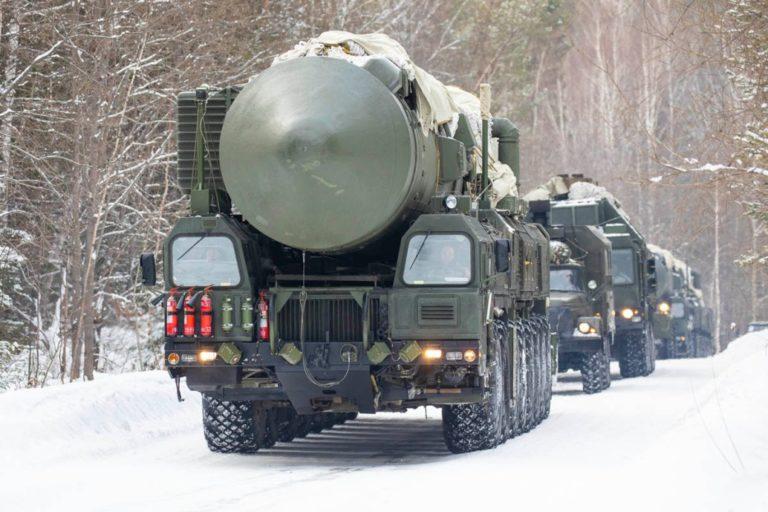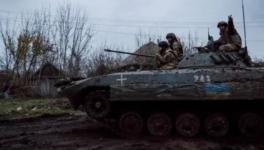Biden Tweaks Ukraine Narrative

Yars ICBM launchers participated in drills of Russian Strategic Rocket Forces, Ivanovo region, northeast of Moscow, June 1, 2022
The US President Joe Biden’s op-ed in the New York Times on Tuesday on the Ukraine war starts with a bluff. He says President Vladimir Putin had thought Russia’s special operation would only last days. How Biden arrived at such an estimation is unclear. Like the US narrative on the war, it is largely presumptive.
Russians are rooted — and well-founded — in their belief that Ukraine has become an American colony and the leaders in Kiev are mere puppets. How could Putin and his Kremlin advisors have estimated that the special operation would be a cakewalk? The core objectives of the special operation are such — a treaty affirming Ukraine’s neutral status and its recognition of Donbass republics as independent states and Crimea as an integral part of Russia — that an operation that “would last days” wouldn’t secure them.
Moscow knew that the US had absolutely no intentions to accommodate Russia’s legitimate security concerns regarding NATO expansion into Ukraine that were formally projected in December in writing.
That is the main reason why the Russians have no timeline for their special operation. They would love to round it off the soonest but knew that the integration of Ukraine’s southern regions — Zoporozhia, Kherson, Mykolaiv — that is vital for Crimea’s economy and security and Ukraine’s Black Sea Ports was not going to be child’s play and might be a long haul.
In the fourth month of the special operation only, Putin could decree the streamlining of procedures for Russian citizenship from applicants in the Kherson, Zoporozhia regions of southern Ukraine.(here, here and here)
Zaporozhye Region in southern Ukraine has offered Russia a military airfield in Melitopol and a naval base in Berdyansk on the coast of the Sea of Azov. The Kherson region plans to integrate into Russia’s education system. Cars are using Russian number plates, Russian SIM cards operate internet and phones. Suffice to say, the shoe is on the other foot.
It was Biden who thought that Russia could be thrown away like a piece from a chessboard but only to realise belatedly that life is real. Biden threatened to render Russian currency rouble as mere rubble and destroy the Russian economy. Having been a hatchet man as a professional politician, Biden never really understood the resilience, fortitude and grit of the Russian people or their historical consciousness and psyche to rally behind Putin.
In the NYT op-ed, Biden thinks he makes a personal gesture toward Putin by promising that he “will not try to bring about his ouster in Moscow.” Yet, Putin’s rating in his country is around 80%, while Biden’s is less than half of that — 36%!
Herein lies the predicament of the Biden Administration. The US is groping in the dark about the Russian intentions in Ukraine. It keeps improvising and updating its narrative to cope with emergent realities that keep coming as nasty surprises.
This is not only about the military part but also about Russia’s political roadmap. The only constant in Washington is about providing Ukraine with “advanced” weaponry — but then, that is also either about regenerating lucrative business for the military-industrial complex by fuelling wars abroad, or, compensating for NATO allies who transfer their Soviet-era redundant stockpiles to Ukraine.
Nonetheless, Biden proclaims in his op-ed that he will “stay the course” and the massive aid to Ukraine will continue “in the months to come.” That said, Biden makes a nuanced presentation in the op-ed, where, apart from the iteration of usual catechisms — about “a democratic, independent, sovereign and prosperous Ukraine”; allied unity; unprovoked Russian aggression; “rules-based international order”, etc. — he does some messaging as well to Moscow as the war graduates to a new phase.
For a start, he no longer makes any false promises to send the Russians packing to Siberia. Biden doesn’t predict winners and losers. On the contrary, he acknowledges that this war can only have a diplomatic solution. He signals modestly that such massive scale of US military aid may put Kiev “in the strongest possible position at the negotiating table.” Carefully drafted words.
Elsewhere, Biden estimates that the focus of the Russian operation is “to take control of as much of Ukraine as it can” before negotiations begin. Implicit here is the realisation that the Russians have turned the tide of the war and a reversal of fortunes is not to be expected.
It is from such a rational perspective that Biden’s uncharacteristic avoidance of vituperative and belligerent rhetoric toward Russia (or Putin personally) needs to be understood. He reaffirms categorically: “So long as the United States or our allies are not attacked, we will not be directly engaged in this conflict, either by sending American troops to fight in Ukraine or by attacking Russian forces. We are not encouraging or enabling Ukraine to strike beyond its borders. We do not want to prolong the war just to inflict pain on Russia.”
Of course, Washington will “continue cooperating” with allies regarding sanctions — “the toughest ever imposed on a major economy” — but Biden won’t evaluate its effectiveness. He promises to “work with our allies and partners to address the global food crisis that Russia’s aggression is worsening,” but won’t allege anymore that world food shortage is Russia’s creation. He will help European allies and others to “reduce their dependence on Russian fossil fuels” but also links it to “speed our transition to a clean energy future.” There is no acrimony.
As regards the security issues, Biden reiterates the US policy to continue “reinforcing NATO’s eastern flank with forces and capabilities” and welcomes Finland’s and Sweden’s applications to join NATO — “a move that will strengthen overall U.S. and trans-Atlantic security by adding two democratic and highly capable military partners” — but refrains from directly linking either of these to Russian aggression.
Most important, Biden retracts from the dramatic prognosis by CIA Director William Burns that under military pressure, Putin might order use of tactical nuclear weapons in Ukraine.
The sombre tone of Biden’s words is in sharp contrast with his own intemperate and tendentious past remarks. This eschewal of the “big macho tough guy” image betrays that some degree of realism is appearing in the US official narrative. But, on the other hand, Biden also discloses in his op-ed that the US will provide the Ukrainians with “more advanced rocket systems and munitions that will enable them to more precisely strike key targets on the battlefield in Ukraine.”
All this adds up to a calculated signal to Moscow, no doubt. But it isn’t easy to resurrect the Atlanticist inclinations in the Kremlin. The tortuous policy procrastinations on NATO expansion through the past quarter century have cost Russia dearly in lives and treasure. That folly or naïveté — depending on one’s viewpoint — shouldn’t repeat.
Again, stalling the momentum of the special operation at this point would carry immense risks. The operation almost lost momentum on the outskirts of Kiev in March due to the “stop-and-go” approach.
Fundamentally, there has been certain inevitability about the Western sanctions, with or without the Ukraine crisis, aimed at weakening Russia permanently. The compass is now set. Therefore, no matter the deliberate sobriety of Biden’s op-ed, the big picture cannot be wished away.
Indeed, the Russian Strategic Rocket Forces held drills in the Ivanovo region, northeast of Moscow today, the day after Biden’s op-ed appeared.
The Russian Defence Ministry said some 1,000 servicemen participated in the drills using over a hundred vehicles, including Yars intercontinental ballistic missile launchers, which have the capability to launch the MIRV-capable (Multiple Independently-targetable Reentry Vehicles) thermonuclear RS-24 Yars inter-continental ballistic missile with range of 12,000 km that can carry up to 10 warheads and cruise at speeds of up to 24,500 km per hour.
Get the latest reports & analysis with people's perspective on Protests, movements & deep analytical videos, discussions of the current affairs in your Telegram app. Subscribe to NewsClick's Telegram channel & get Real-Time updates on stories, as they get published on our website.























